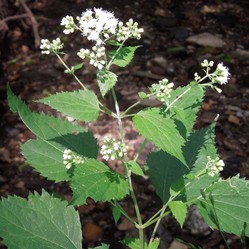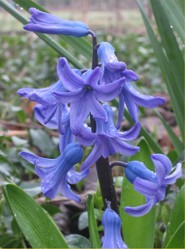Plant and animal classification is called taxonomy.It is a Greek term, although most classification uses Latin, which was the language of European scholarship for many centuries. Taxonomy can be very simple,but the science that goes into it can be a complex mix of biochemistry and genetics.Moreover, since I was at school taxonomy has made significant changes because of the use of genetics. When reading botanical literature it helps to grasp the terms used.
Understanding Plant Classification
by frankbeswick
When you are purchasing plants it is helpful to understand how they are named and classified.
Species and Above
The first successful scientific plant taxonomy came from Linnaeus, a Swedish botanist who dedicated his life to not only thinking up a classification system, but to working out which plants fitted where in it. He took the terms genus and species, which had been used by the Greek philosopher and early scientist Aristotle and used them as the basis of his system. But he added more categories than Aristotle had thought of. Later scientists have adapted the Linnaean system, though much of it remains intact.
Linnaeus gave a double name to each plant, in Latin. Let us take the example of Brassica oleracea, commonly known as cabbage. The genus [Brassica] is like the surname, indicating the group of related species to which cabbage belongs. The genus always starts with a capital letter; oleracea denotes the species, and except at the beginning of a sentence is not capitalized. The scientific name differs from the common name,which can vary country by country or even locally. Two or more unrelated plants can share the same name in different countries. Some species are very varied. Did you know, for example that Brassica oleracea contains cabbage, cauliflower.kale, sprouts and some others, but some species are not very varied at all. Some genera are vast, containing many species, but some, like Gingko contains only one.In fact the taxonomical category above genus is a family. The Gingko family has only one genus, with only one species, but some other families like the Rosaceae are enormous. Sometimes taxonomical families are renamed, for example the Brassicacea used to be named the Cruciiferae, until scientists decided that names should have standardised endings. At other times plants are reclassified into a different genus, so sometimes this can be confusing for lay people, but reclassification is done on the basis of the best science available.
Do not think that two similar plants must be related.Spring crocus and Autumn crocus look similar. but they belong to different plant families.But who would be able to tell from just visual examination that tomatoes, potatoes and eggplants belong to the Solanaceae family?They do suffer the same diseases!
The basic taxonomical unit is the species, and a genus is a group of related species. A species is a breeding unit, but generally species within the same genus can hybridise. We in Britain find that the two native species of hawthorn, which belong to the genus Crataegus, hybridise very easily.If you see an X between genus and species you know that you are dealing with a hybrid. But look at this name X Cupressocyparis leylandii. Having the X first indicates an intergeneric hybrid, a cross between plants of two different genera,
Families are grouped into orders, all of which end in the letters -ales, e.g.the Lillales; and the Liliales belong to the Class Liliopsida, which belong to the division Magnoliaphytes. Above that is the kingdom Plantae. Higher than this we find domains, but this involves complex microbiology and is not needed at the garden centre!
Below the Level of Species
You need to know this if you want to breed plants, especially if you are showing them at flower shows. You also need to know because knowing determines how you propagate a plant, for plants can be propagated in a variety of ways. You need to know the difference between subspecies, variety, cultivar and form.
Let's look at Salix alba caerulea, the cricket bat willow, from which all the best cricket bats are made. It is a subspecies of Salix alba, the white willow. But this subspecies seems to favour a specific area and has never taken well to growing away from Eastern England. So it is a very distinct variety that has a limited geographical range. Hence it is a subspecies.
If you see var, after the species name but before another name you know that you are dealing with a variety. which is smaller in rank than a subspecies. Some varieties may be propagated by seed, but because pollen flies around a variety may not always breed true, so to breed true you need vegetative propagation, e.g.cuttings, which clone the plant.There is such a rank as subvariety, but it is rarely used.
Let's take an example, Rosa "Gertrude Jekyll" When you see a non-Latin name in speech marks it indicates a cultivar. This is a variety produced by selective breeding for some desirable characteristic. Generally cultivars are not grown from seed, but by vegetative propagation, as cloning is the only way to ensure that the cultivar is preserved. Note that in this case the species name is not given. This is because it has such a long history of breeding behind it this rose is the product of several hybridisations.
The lowest category is a form, which is denoted by an f. before the final term in the name. It denotes a group of plants within a variety, not necessarily from a common ancestor, that share a distinct morphological characteristic, such as colour. The term form is used exclusively for ornamental plants. There is no use for such a distinction in the field of vegetable cultivation. In fact, vegetable growers rarely need to talk about cultivars, for them the term variety is about as far as they need to go.
Clades.
Plants are harder and more complex to classify than animals are because they can have a number of chromosomes much higher than animals have, a situation known as polyploidy. This led to taxonomical confusion with there being the development of subcategories such as sub-family or super-order, to name but two representative examples. Furthermore, scientists, while acknowledging their debt to Linnaeus, began to realize that his method of classifying plants according to their sex organs was inadequate. Genetic analysis came to the rescue as DNA sequences were unravelled.It soon became clear that genetically unrelated plants were being classed together in some cases. This was a challenge to taxonomy, as there had long been an assumption that similarity meant relationship.
Then scientists came up with the concept of clades, which gave us the science of cladistics. A clade is a group of living beings descended from the same ancestor, a relationship that can be mapped out by genetics. Cladistics has been a great boon for botany, as it has clarified botanical relationships and helped to rewrite the science of taxonomy. Scientists have retained the old Linnaean nomenclature and even hold on to sub and super categories where convenient, but do not feel a need to add to them. Now in taxonomical schemes you will see, for example, between an order and the two families below it the statement clade, with a scientific name. This clade may be the link between two botanical families, a common ancestor.
A knowledge of taxonomy is of general benefit to gardeners and farmers as knowing to which families plants belong alerts us to the diseases to which a specific family are susceptible. For example, the Solanaceae [potatoes, tomatoes, eggplants, etc] suffer from blight. Knowing taxonomy also shows you which plants go where in a crop rotation. For example,how many people know that, while it is a root crop, a turnip is not related to onions or carrots, but to cabbages. It is a Brassica.
You might also like
My Successful Search for Edible LandscapingMany years ago, I went on a quest to find the best edible landscaping for Flo...
White Snakeroot - A Versatile and Little-Known WildflowerWhite snakeroot, Ageratina altissima, is a wildflower native to Eastern North...
Early Spring Colors in the Yard: Blue, Lavender, Purple, YellowSpring announces its arrival with a palette of colors for early spring flower...





 Women of the Gospelson 10/11/2025
Women of the Gospelson 10/11/2025
 Religious Gardenson 08/25/2025
Religious Gardenson 08/25/2025
 Doctor of the Church: John Henry Newmanon 08/03/2025
Doctor of the Church: John Henry Newmanon 08/03/2025
 Restoring the Palm Houseon 07/16/2025
Restoring the Palm Houseon 07/16/2025



Comments
Willows in general seem resistant to the worst pests.
Thank you for your comment below in answer to my previous observation and question.
It's reassuring to hear of a plant species not susceptible to disease. Might such an attractive species so attractive also in its processed form have any pests to worry about?
It is not susceptible to disease.
Thank you for your comment below in answer to my previous observation and question.
That cricket bat willow grows in such a restricted area intrigues me. Is it basically disease- and pest-free?
Probably it is natural.
Thank you for your comment below in answer to my previous observation and question.
English Wikipedia advises us that cricket bat willow may be a "hybrid between white willow and crack willow."
Might that hybrid be natural or resulting from cricket-bat industry research?
Research. The cricket bat willow is a subspecies that only flourishes in a small area of Eastern England. I do not think that it would flourish elseware.
Thank you for your comment below in answer to my previous observation and question.
That cricket bat willow (Salix alba caerulea) doesn't encourage growing indoors intrigues me. If only I might do so...!
What might motivate someone to plant cricket bat willow in a conservatory or greenhouse? Would it only be on the research level?
Growing it inside has never been tried, so I cannot say.
frankbeswick, Thank you for the practicalities and products.
Ismail Kadare's novel The Concert has a character who grows a lemon tree inside as a symbol of her standing and because it wouldn't grow well outside where she lives. Is it possible that cricket bat willow (Salix alba caerulea) would grow inside where it won't grow outside away from eastern England?